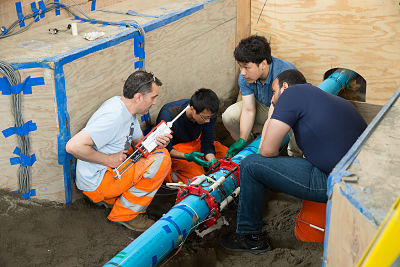Submitted by L. Millard on Wed, 14/06/2017 - 13:17
CSIC assisted researchers at the Cornell Geotechnical Lifelines Large-Scale Testing Facility, in Ithica, New York, last month to install fibre optic sensors in readiness for a first-of-its-kind experiment.

Photograph: CSIC technicians oversee the installation of fibre optic sensors at the Cornell Geotechnical Lifelines Large-Scale Testing Facility in Ithica, New York
Modern infrastructure, including buildings and bridges, are gaining the ability to collect and exchange valuable data using wireless devices that monitor their structural health in real time. But wireless systems for underground infrastructure, such as utility pipelines, are much more difficult to test in the field, especially during rare and extreme events such as earthquakes.
The Cornell facility is seeking to address this challenge by testing several advanced sensors developed by researchers at the University of California, Berkeley, and the University of Cambridge. The sensors – which can collectively measure strain, temperature, movement and leakage – were installed along a 40-foot section of a hazard-resilient pipeline being tested for earthquake fault-rupture performance.
The pipeline itself is innovative, produced by the company IPEX using a molecularly-oriented polyvinylchloride material engineered to stretch, bend and compress as it withstands extreme ground deformation similar to that occurring during earthquakes, floods and construction-related activity. Engineers from Oakland and Vancouver travelled to Ithaca in order to study the pipe as it experienced a simulated fault rupture while buried inside a hydraulically powered ‘split basin’ filled with 80 tons of soil.
The test marked the first use of the advanced sensors for the purpose of monitoring buried infrastructure, and gave an unprecedented insight into the pipe’s ability to elongate and bend while being subject to ground failure. “It was a fantastic performance. It did really well,” said Brad Wham, a geotechnical engineering postdoc. “It was able to accommodate 50 per cent more ground deformation than the last design based on modifications Cornell suggested from our testing four years ago.”
In addition to the scores of instruments installed for the large-scale test, new technologies employed included:
Distributed strain sensing – A laser pulse is injected through an optical fibre cable glued to a pipe. By examining the interaction signal that is generated at every point of the fibre, it is possible to obtain strain values continuously along the pipeline.
Fibre Bragg grating sensing – A special fibre optic line that splits and diffracts light into wavelengths, allowing it to monitor bending and axial deformations accurately at discrete points, especially at pipe joints.
Frequency-domain reflectometry wireless sensor network – Metal prongs that use an electric field to measure changes in soil moisture and detect leaks. The device is battery powered and can wirelessly transmit data through soil using a coupled magnetic induction and electromagnetic wireless sensor network system
Smart joint-opening detection – Small magnets are attached at pipe joint locations. Once a pipe has stretched or compressed to a specific limit, the magnets conjoin to trigger the wireless sensor network to initiate the monitoring.
The sensors drew interest from the attending municipal engineers looking for new ways to monitor the performance of underground infrastructure. As cities begin to employ the sensor technologies more data will exist – for both infrastructure and the surrounding environment. “You can learn something about sources of subsidence, corrosion that affect other structures, or something about the geographic distribution of earthquake or hurricane damage, which then allows you to make improved decisions about emergency response,” said Tom O’Rourke, Professor of Civil and Environmental Engineering, primary investigator of the research project, and chair of CSIC’s International Advisory Panel.
The experimental test also demonstrated how sensors provide valuable feedback to companies like IPEX that want to advance the engineering behind new products and improve system-wide performance.
“This is about having feedback and intelligence for underground lifeline systems, such as water supplies, electric power and telecommunications, which provide the services and resources that define a modern city,” said Professor O’Rourke. “It’s pretty clear to me that within 20 years there will be intelligence integrated into every aspect of infrastructure.”
“The vision we have is that our future infrastructure looks after itself by sensing and adapting to the changing environment,” said Kenichi Soga, Professor at U.C. Berkeley and CSIC Co-Investigator. “Rapidly developing sensor technologies and data analytics give us the opportunity to make this happen.”
The research team will now excavate the pipeline and begin to analyse the mass of data collected by the sensors. “It’s going to be game changing,” said Brad Wham, explaining that some of the devices are capable of recording up to a thousand measurements per second or more. “We have many, many gigs of data right now for measurements that were previously unattainable.”
This news story is based upon an original article by Syl Kacapyr which appeared in Cornell University’s Cornell Chronicle. Read the article here.
